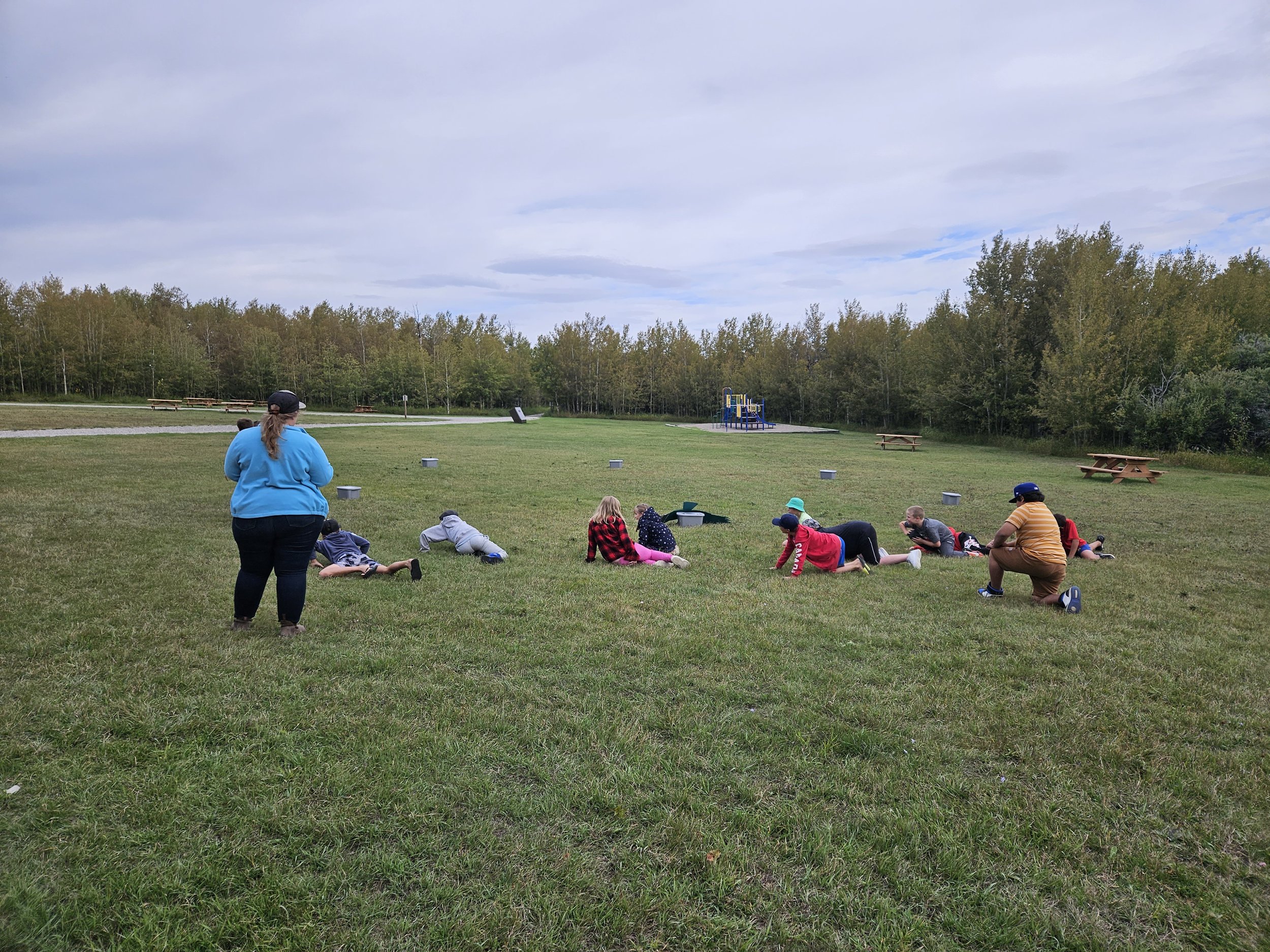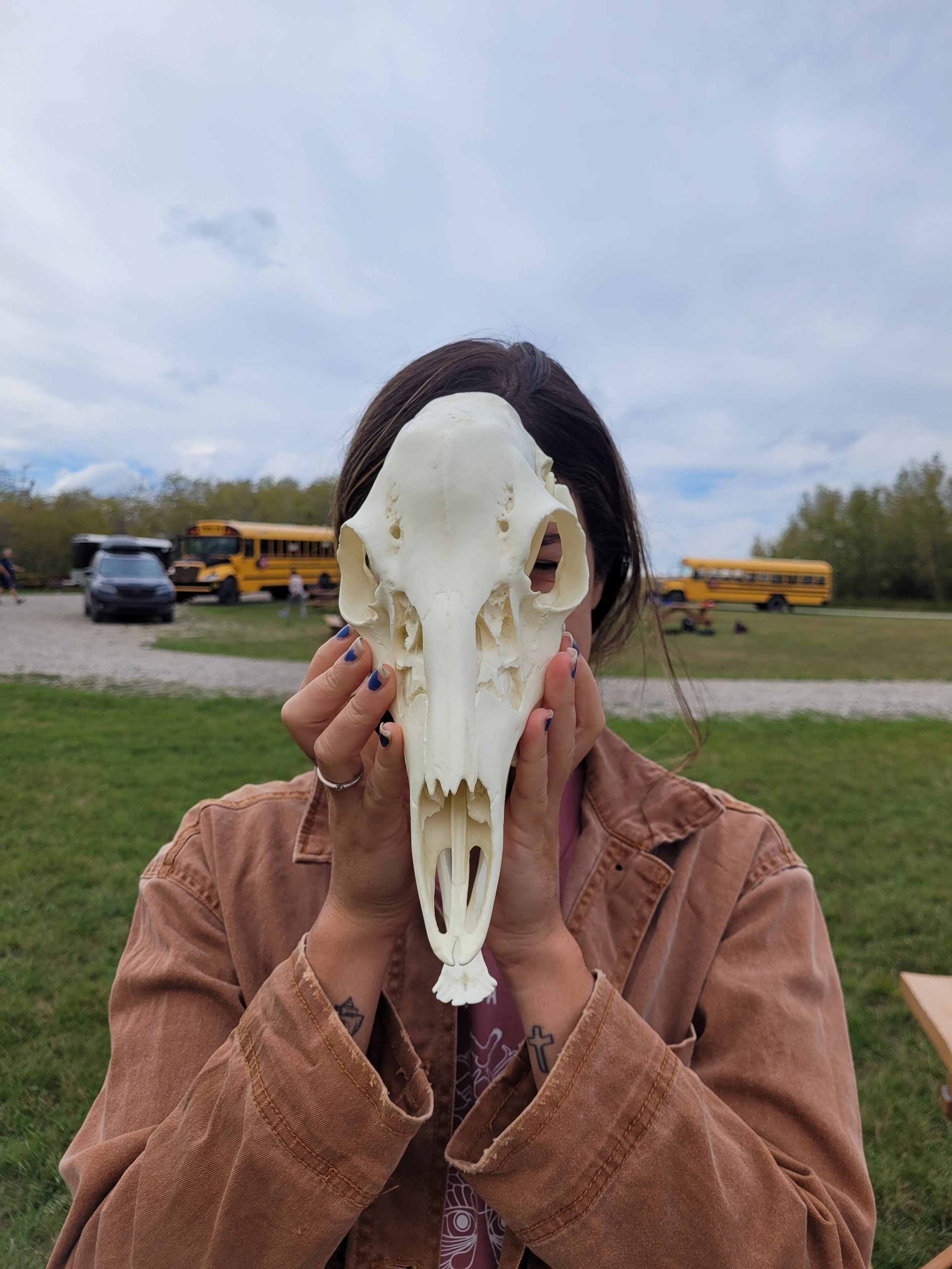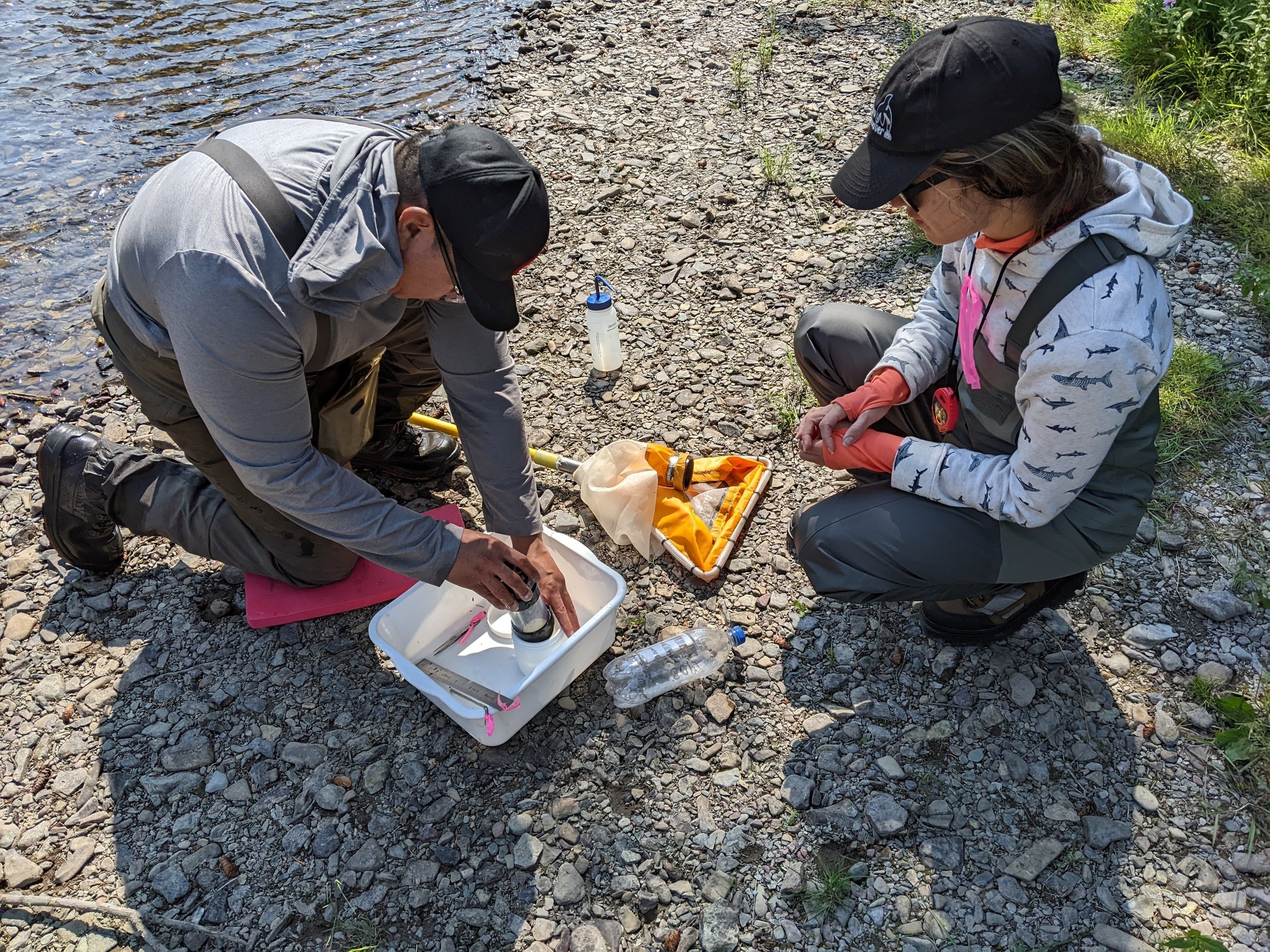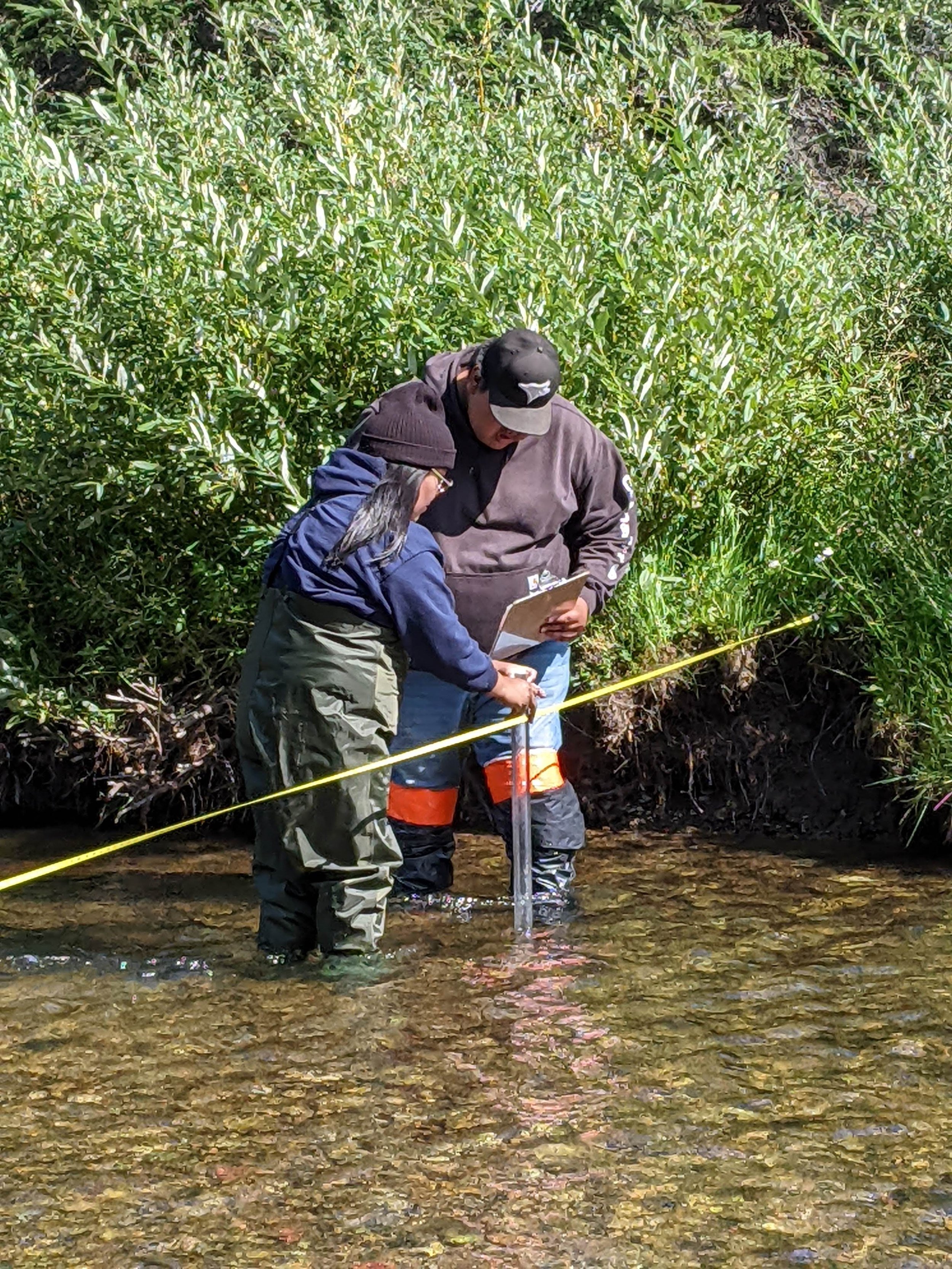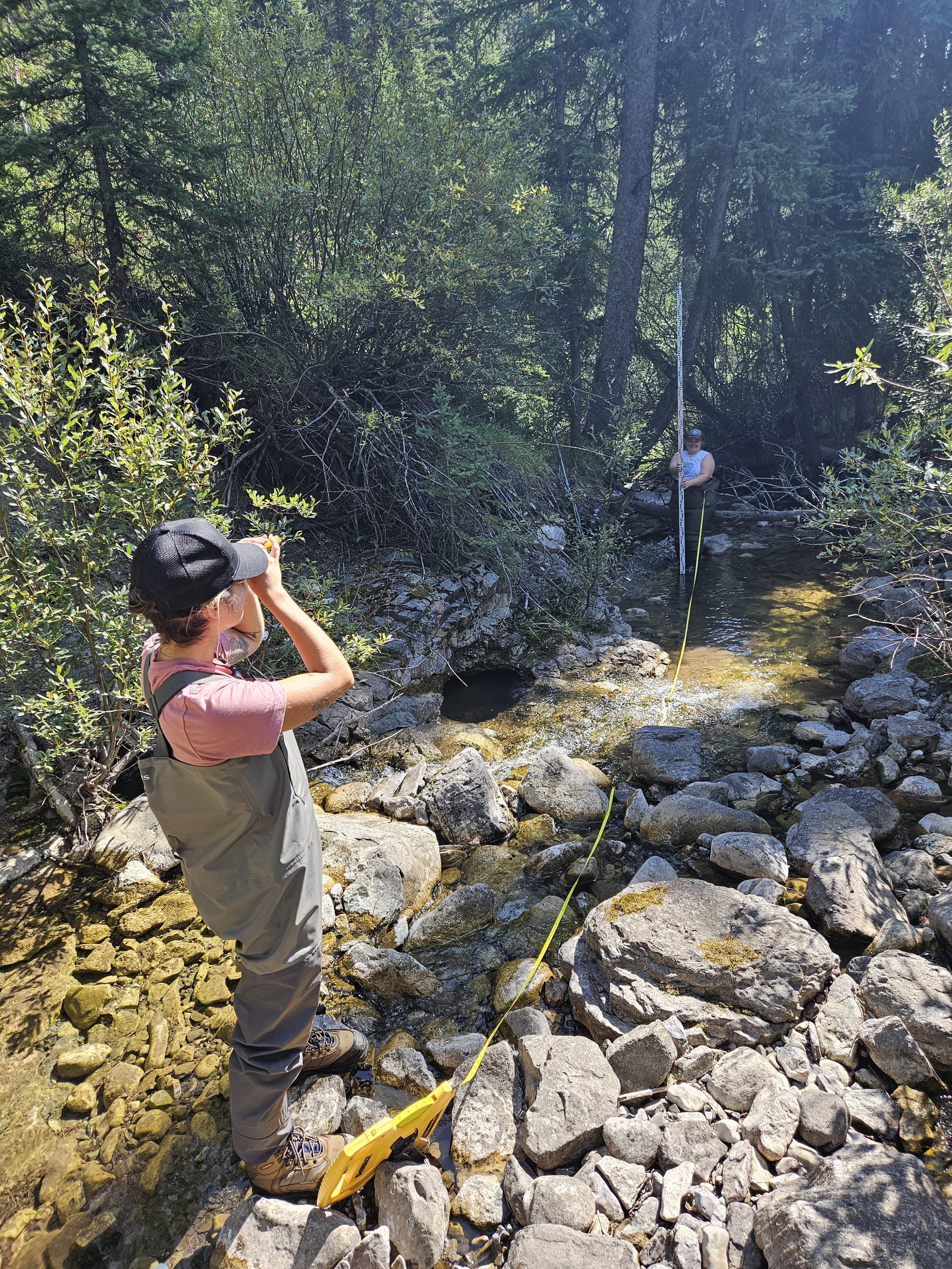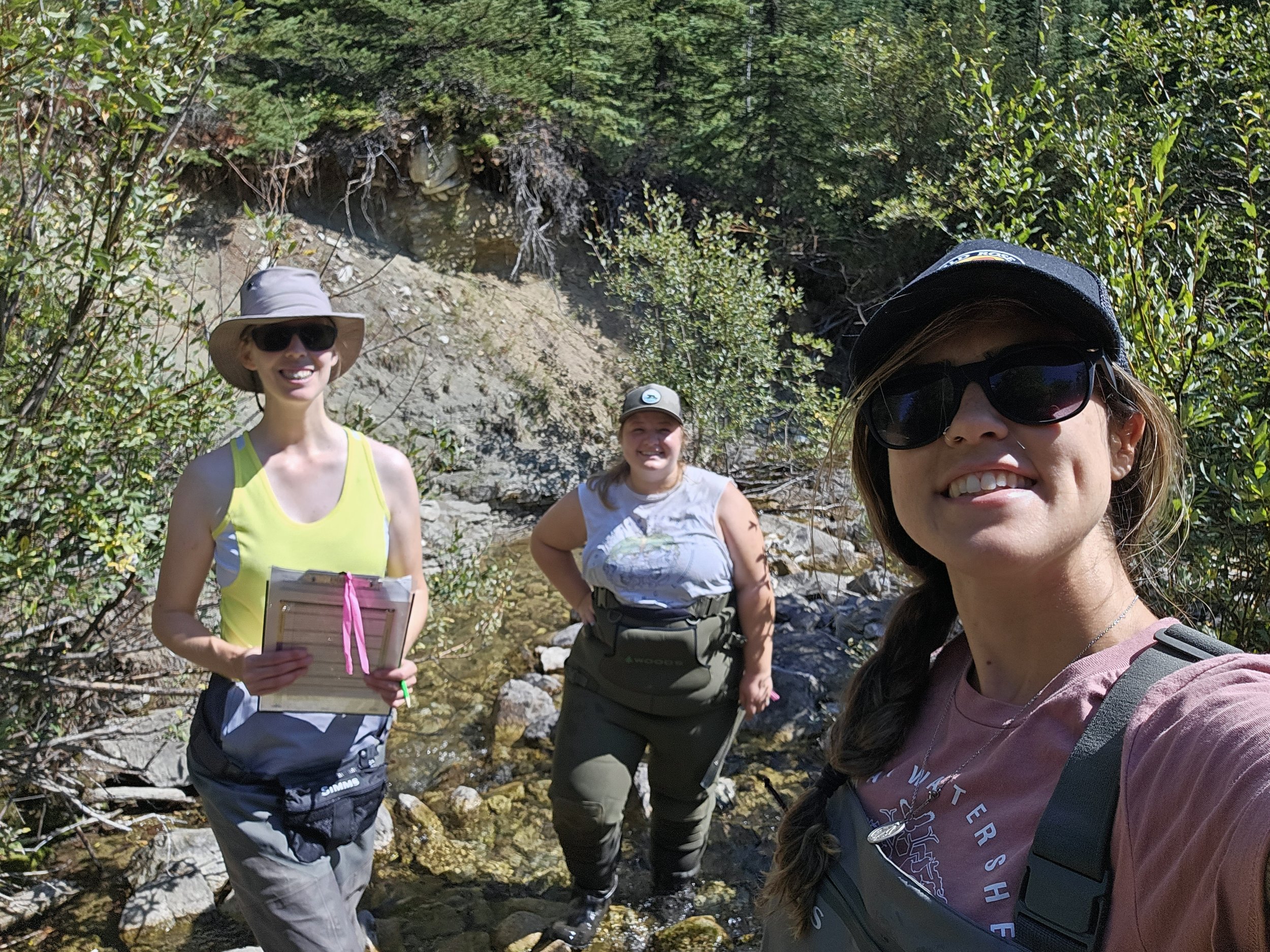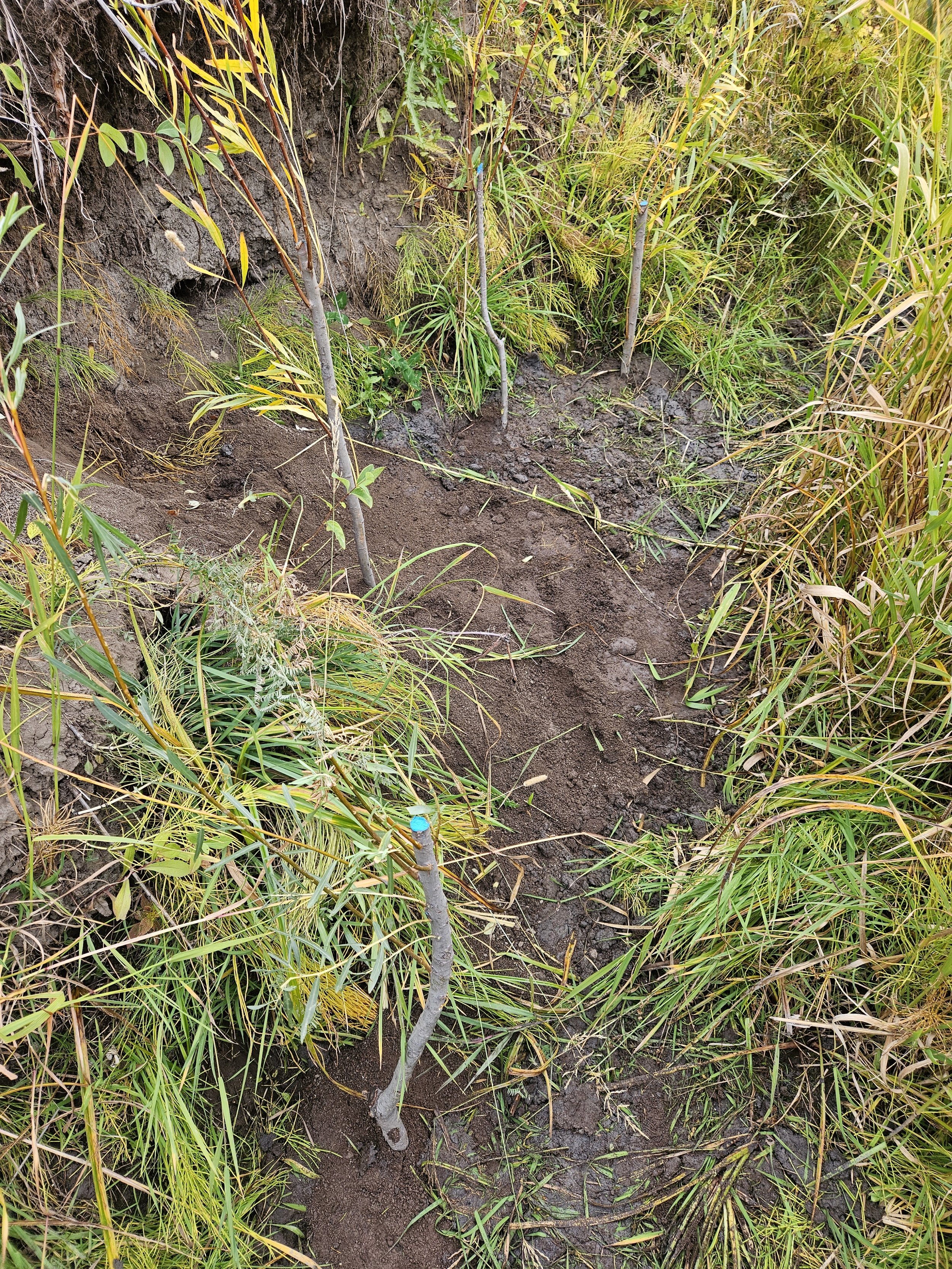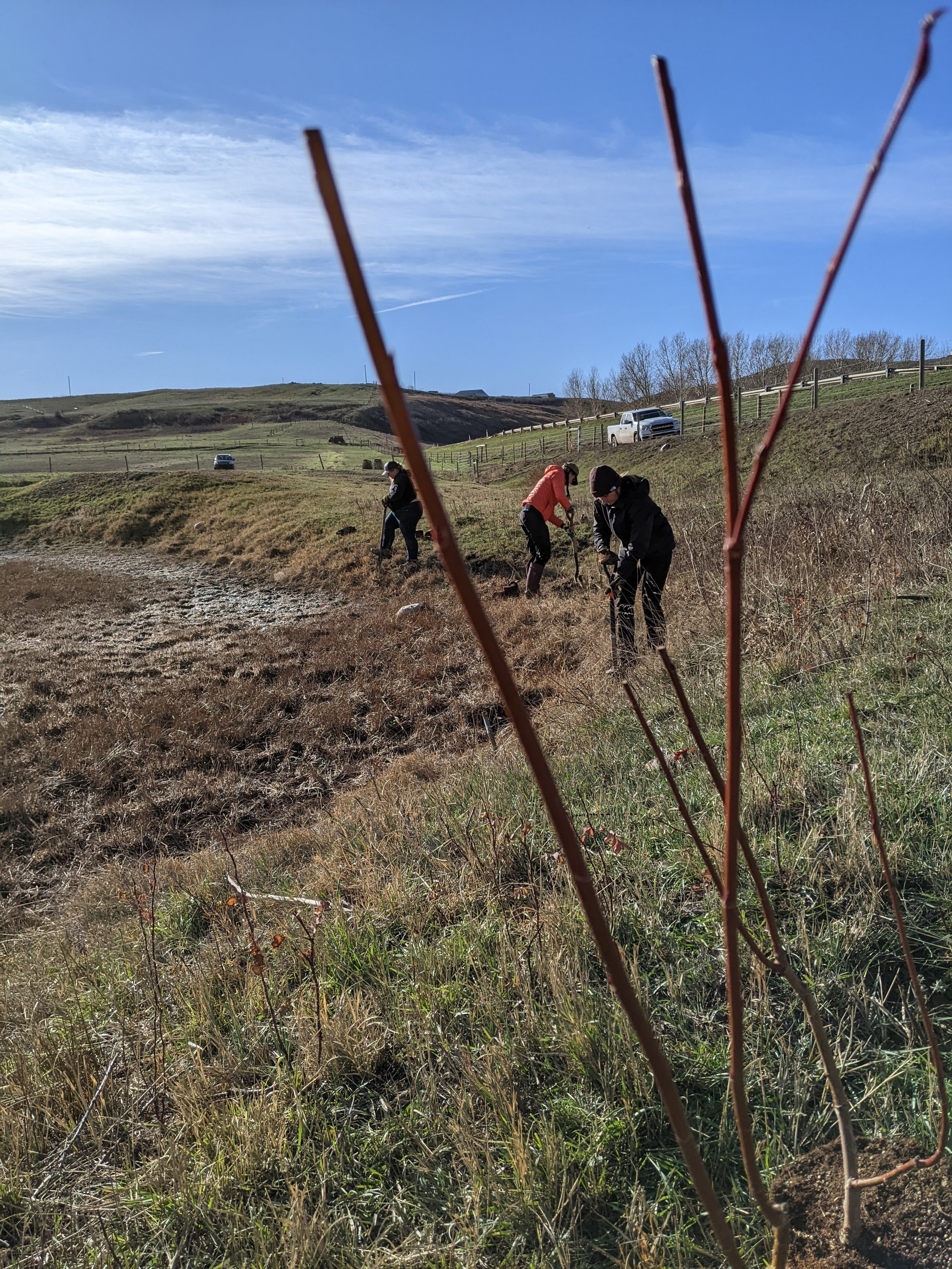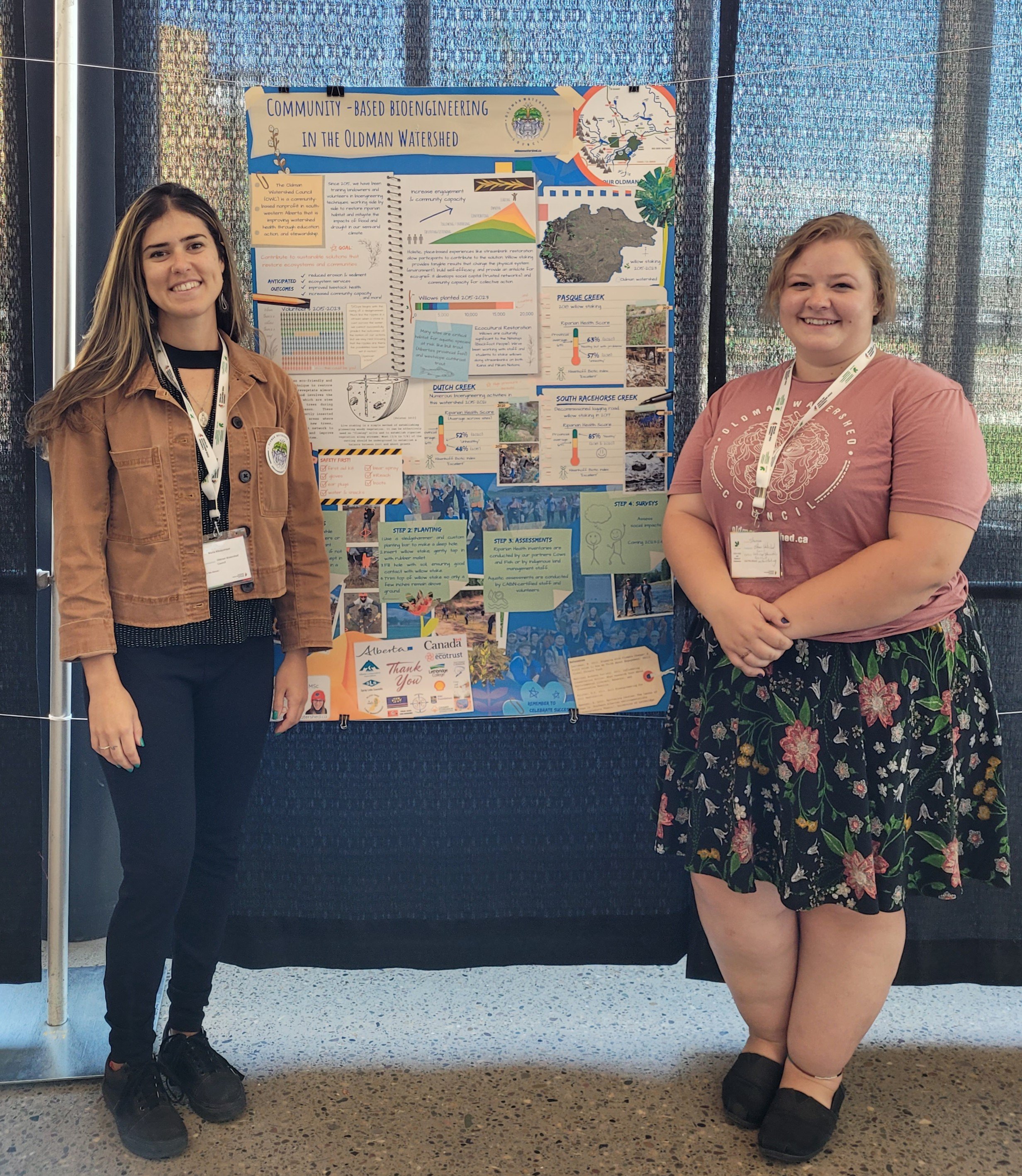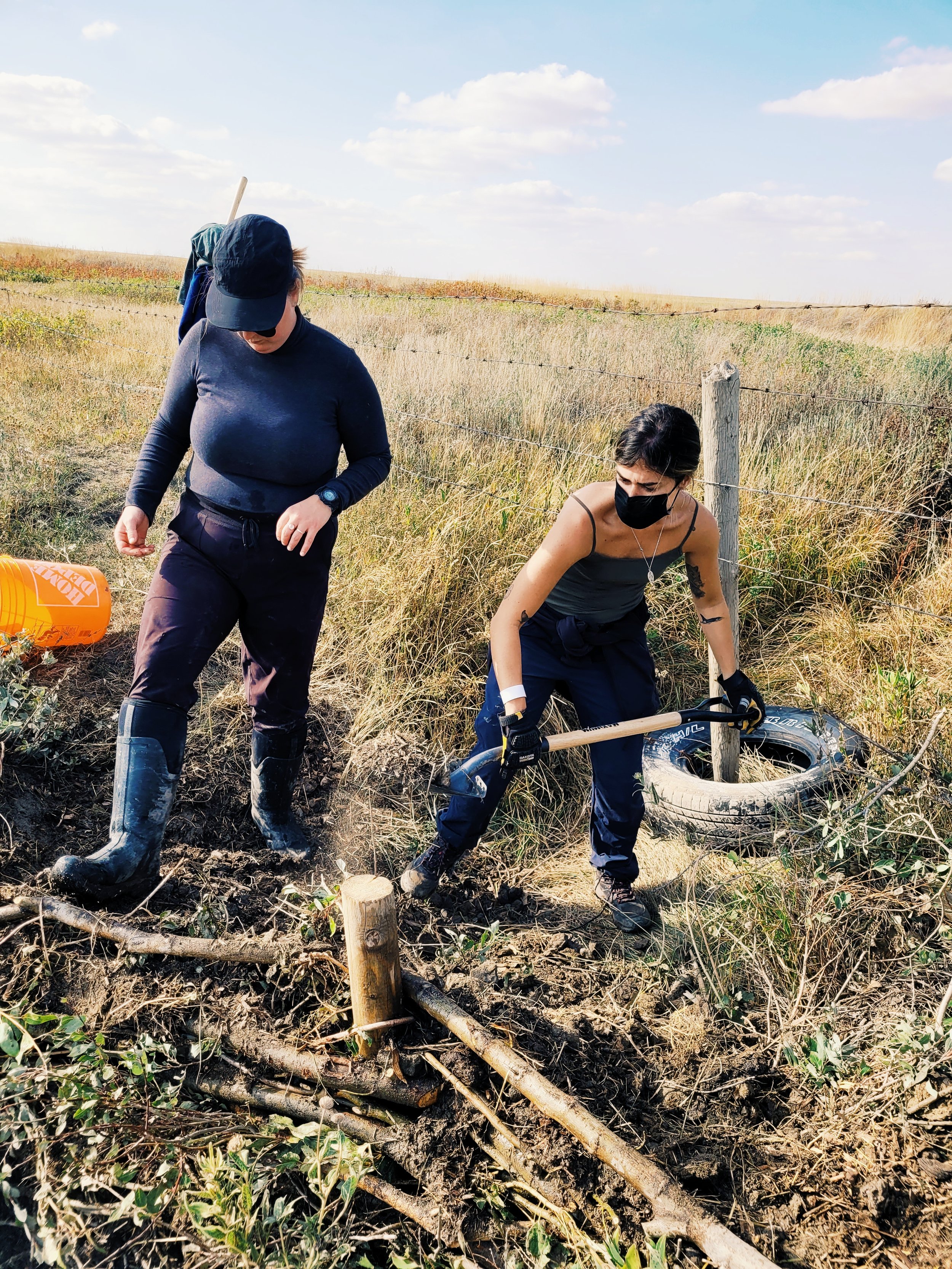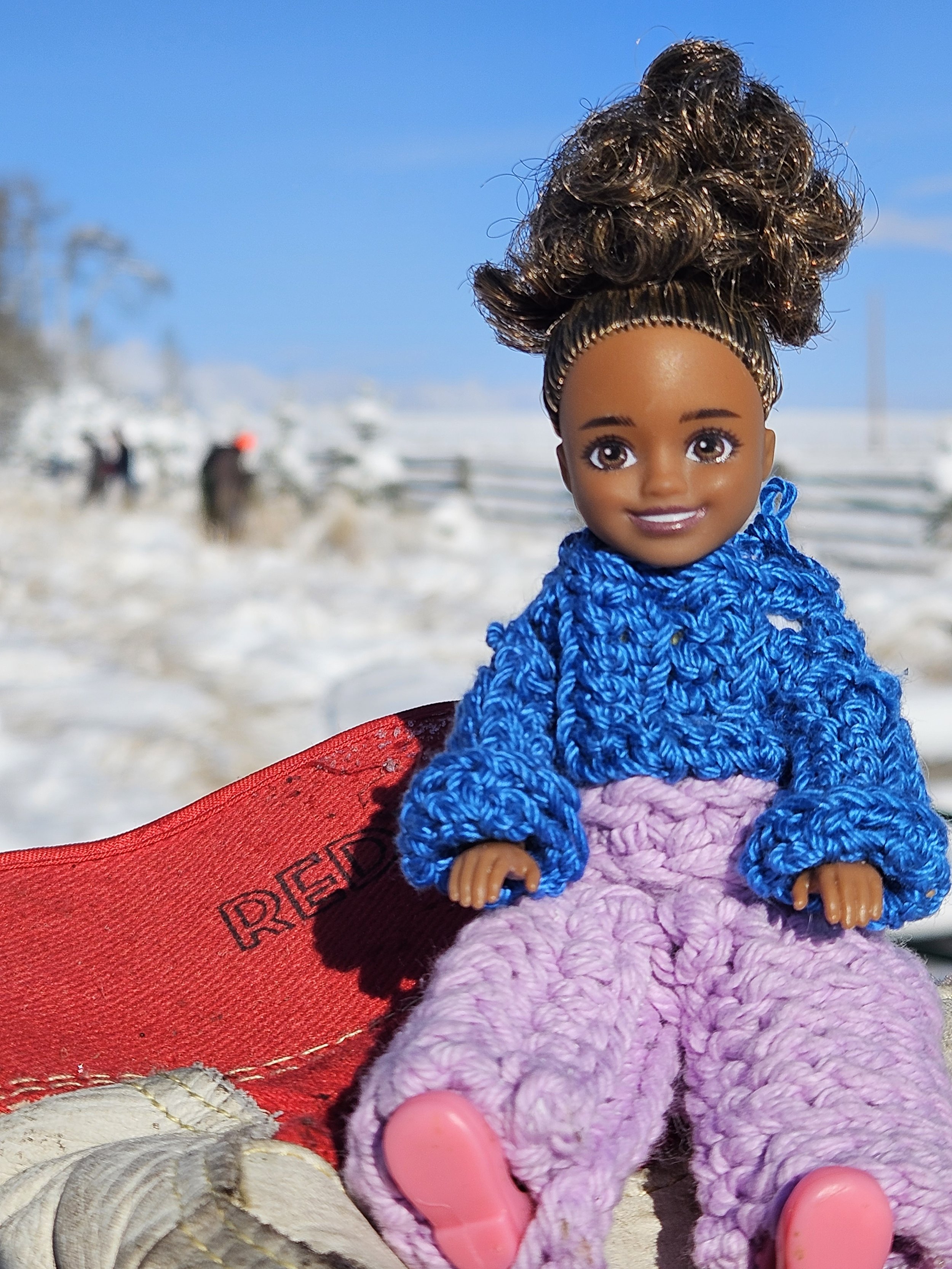by Shannon Hart and Maria Albuquerque
Colourful leaves, wind chill, and willow staking, oh my! From highs of 27°C to lows of -13°C, this fieldwork season was intense but wonder-fall! We participated in many different projects and programs throughout the Oldman watershed, on the stunning lands of Treaty 7 Blackfoot Territory. We spent roughly 200 hours in the field with more than 40 watershed heroes throughout the season, including staff and partners from Blood Tribe Land Management, Siksikaitsitapi – Blackfoot Confederacy, Cows and Fish, Livingstone Landowners Group, Trout Unlimited Canada, Waterton Biosphere Reserve, MD of Crowsnest Pass, Alberta Environment and Protected Areas, The Miistakis Institute, Lethbridge College, and many brave volunteers!
We all got our hands dirty and feet wet with willow planting, stream sampling, building beaver dam analogs, and educating students; we also enjoyed many great coffee and treats from local vendors.
School’s Out…side!
Did you know that ospreys have incredible eyesight and can see most things on the ground in detail while flying as high as a plane? Or that a deer’s hooves allow them to move quietly, helping them to avoid predators ? These are just a couple facts that Grade 5 students from Cardston learned at Wetland Field Day, an annual school program organised by the Waterton Biosphere Reserve Association. Even Ms. Frizzle and her Magic School Bus couldn’t dream up a field trip this fun and educational! It was great facilitating the program and engaging with the students about animal adaptations in our watershed. In addition to handling both real and model specimens, we had a lot of fun playing a predator-prey game.
Checking out our Live Streams
CABIN is a national program that measures the health of freshwater systems through the collection of benthic macroinvertebrates (aquatic insects). Different species can tolerate varying water conditions, so these bugs can be used to indicate water quality. Water samples and habitat measurements are also taken; all of this creates baseline data for long-term monitoring of the health of our local streams. This year, Maria and three others were trained in the CABIN sampling protocol and were able to apply their newly acquired knowledge to collecting field data for OWC together with other CABIN-certified staff and volunteers!
This year’s drought made our stream-hunting more challenging, as many creeks were too low for sampling in the fall. Despite this, we were still able to sample several streams, including potential reference sites! A reference site means that the area sampled has had very minimal human disturbance or impact. The information obtained through the aquatic bugs and water testing in that stream can be used to evaluate test sites with similar habitat. Depending on how different the results from the test to the reference site are, we can tell how the local habitat has been impacted. We can’t wait to receive the results and learn more about our streams' health!
The Wind in the Willows
This fall, OWC tried a new experiment: we planted rooted willows to see how their survival will compare to unrooted willow stakes. It requires a little more work since you have to dig actual holes to plant the pots, but the willow already has roots and shoots. Thanks to the hard work of our partners and volunteers, there are 4,776 new willows in the Oldman watershed since April 1. Willows continue to be our choice to restore and stabilize streambanks throughout the watershed. In July, OWC presented our bioengineering project at the Canadian Society for Bioengineering Annual Conference at Lethbridge College.
BDAs on Autumn Days
While dam building can be a one-beaver job, for humans, beaver dam analogs are a team effort. Shannon, Maria, and Eamon, our student volunteer, worked closely together with Blood Tribe Land Management, the Miistakis Institute, and Cows and Fish to install beaver dam analogs in a seasonal creek bed located on Kainai Nation. BDAs are a low-tech restoration technique that act as speed bumps in the water body. They slow the movement of water and encourage conditions for longer water storage by creating a pond system. After getting started, we soon realized just how long and hard a beaver has to work to make a single dam. They are truly logging in the hours to create a cool and sturdy structure!
Field Notes, Quotes, and Anecdotes
Staff:
What was new and exciting for this field season?
Sofie: This year we CABIN-sampled our first potential reference sites! These are streams that are minimally disturbed. Once we have sampled enough of them, we can use the data to build a predictive model that we can use to assess our "test" sites, like the streams at our restoration sites. OWC's CABIN sampling program has been funded for the past several years by the Forest Resource Improvement Association of Alberta via Spray Lake Sawmills, and now a grant from the Alberta Ecotrust Foundation is helping our grassroots biomonitoring collaborative begin working on the very first CABIN reference model for Alberta's Eastern Slopes. It will take several years to complete, but we are very excited to get started! Another exciting highlight for me this season (although not directly fieldwork per se) was travelling to Darwin, Australia to share our amazing work with a global community of restoration practitioners and researchers, at the 10th World Conference on Ecological Restoration. The theme was "Nature and People As One: Celebrating and Restoring Connection," and OWC's work was very well received.
What is the best part of working in the field in the Oldman watershed?
Shannon H: I think it’s a tie between who we work with and where we work. We are constantly collaborating with so many wonderful people in the form of landowners, colleagues, and volunteers; it’s great working so positively with each other whilst sharing common goals. As a Southern Albertan, I feel a strong connection to the land here. The areas we work in are so beautiful, and it feels good to know I’m positively contributing to the stewardship of it.
What’s your favourite place to work in the Oldman watershed?
Maria: This is a very difficult question because the Oldman watershed enchanted me at first sight. I do have specific spots that I really admire, like the Oldman river valley with all the cottonwoods around it and the dry coulees with cactus! But for working, I think it is the area between the mountains and the foothills. I love that landscape and you never know when you will spot wildlife! Castle Falls and the Crowsnest Pass were my favorite places to work during this season. I saw a tiger salamander during CABIN training, a moose when CABIN sampling, and a bear on the way to a point duty! These all made my work more fulfilling, reminding me that what we do benefits all of us. Let’s see where else we will work next season, which animals we will see, and which other places I will fall in love with.
What environmental innovations are you excited to see happen in the Oldman watershed?
Emily: I am most excited about the broad-scale adoption of re-naturalization in heavily modified ecosystems, particularly in urban spaces. More and more cities are reassessing and innovating their priorities in urban planning and making space for the inclusion of native vegetation – things like riparian buffer strips, pollinator gardens, native prairie lawns, etc. Incorporating native plants in urban centres can improve climate resiliency, carbon storage, wildlife habitat connectivity, human connection to the landscape, mental health of urban residents, and more (concrete doesn’t do these things).
What is your role at the Oldman Watershed Council?
Chelsea: I’m the Oldman Watershed Barbie; my job is to help promote stewardship and environmental education in the watershed while having fun! Barbie has always been a leader who works hard to inspire people, which is my professional goal. From information booths to building BDAs, I’ve done it all!
Friends of the Watershed:
What is the most surprising thing you learned during field season?
Eamon: The most surprising thing I learned during field season with OWC is how important beavers are on the prairies. Here in the Oldman basin, a unique watershed that doesn’t rely on glacial melt, capturing spring runoff is of the utmost importance. Beavers play a key role in this task as their dams slow the flow of streams, which keeps them flowing for longer into the season. This allows that water to be utilized by plants and animals. Unfortunately, a lot of streams on the prairies no longer have beavers living in them and thus will dry out earlier. I found this especially fascinating while building beaver dam analogues in a dry creek bed with OWC and Blood Tribe Land Management.
What inspires you to do the work you do?
Alyssa: As a Kainai member of the Blackfoot Confederacy, my culture and working with my community is what inspires me to work as an environmental technician; I do this in the hopes that I can contribute in any way in protecting the environment for future generations, including for my own children.
Why do you think collaborating with other environmental organizations is important?
Paul: To me (Vegetation Management crew member, Waterton Lakes National Park), it’s simply logical to cooperate with other organisations and across jurisdictions since we all live in the same watershed and are working towards the same goals. Moreover, collaboration is necessary when managing natural resources with an ecosystem connectivity approach, in order to restore some links between disjointed landscapes and waterbodies. Also, combining resources and strengths among our environmental partners and stakeholders is a convenient way to achieve more goals, share our knowledge and foster public involvement. Lastly, it’s a great opportunity to meet new people and have a fun time outdoors.
Why do you want to work in the environmental industry, and how does volunteering with OWC contribute to your future plans?
Titus: I have always wanted to work outdoors. I grew up in the Pacific Northwest where I was surrounded by nature and the woods were my backyard. Being so exposed to nature allowed my curiosity to fester about the environment and interactions in local ecosystems, which lead me to the career path I'm working towards today. Working with Shannon and Anne-Marie was a blessing, as I got to realize from first hand experience that the people working in my field share a lot in common with me, and see things with a similar lens as I do. Volunteering allowed me to build these valuable connections.
What was your favourite part of willow planting?
Rowan: I liked being able to make a positive impact on the land! Climate anxiety is strong in me, and being able to make small impacts with other like-minded people gives me more hope for the future!
Why did you get involved with the Oldman Watershed Council?
Erik: I initially got involved with the Oldman Watershed out of sheer curiosity as to what WPACs did, and I saw some available volunteer opportunities. Once I met some of the people and started to learn more about the organization, this grew into a connection based on shared interests and goals. Being an aquatic scientist by trade, the fit was all too natural and being in the mountains talking to people or improving the watershed is just a big bonus in my books. Five years and several laborious volunteer events later, here I am still sitting as a member at large on the board.
Giving Thanks
We at OWC would like to extend a massive thank you to our volunteers and partners. This magnitude of work would not have been possible without our community. Residents from around the watershed coming together is the key to a successful field season. If you are interested in making a positive difference in our watershed like these amazing people, then please visit our volunteer portal. Stay connected with us on social media for information on upcoming future OWC exclusive events—you don't want to miss out. We look forward to seeing you all in the spring; have a great winter!
Last day in the field!


